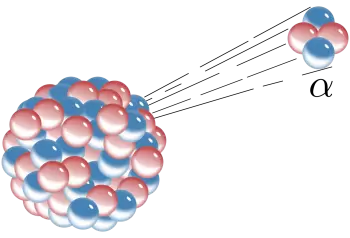
An alpha particle is a positively charged particle emitted by various radioactive materials during decomposition. It consists of two neutrons and two protons and is identical to helium nuclei without electrons. As a result, its mass is similar to the helium atomic mass.
Since they do not have electrons, the total charge of an alpha particle is the same as the sum of the charge of both protons because neutrons have no charge.
Sometimes this decomposition leaves atomic nuclei in an excited state. Consequently, excess nuclear energy can be removed with gamma rays emission.
The binding energy of the alpha particle is about 28.8 MeV, making it highly stable.
What is the specific charge of an alpha particle?
The specific charge of an alpha particle is the ratio between the charge of an alpha particle and its mass. Accordingly, the specific charge of alpha particle 4.8×107 Ckg−1.
Alpha particles have a charge of +2 e. Therefore, its charge is twice the electronic charge: 3.2×10−19 C. Meanwhile, the mass of an alpha particle is approximately 6.6446573357×10−27 kg. Still, if we divide both values, we get its specific charge: 4.8×107 Ckg−1.
What is alpha radiation?
Alpha radiation occurs when an atom undergoes radioactive decay, emitting an alpha particle. In alpha radiation, the parent nucleus is transformed into a daughter nucleus, another element in the periodic table, reducing its atomic weight by 4 daltons and its atomic number by two units.
These particles are a form of radiation typically emitted by radioactive parent nuclei of heavy elements on the periodic table in a process called alpha decay. These heavy alpha emitter elements can be, for example, the isotopes of uranium (U), plutonium (Pu), thorium (Th), or radium (Ra).
Due to their charge and mass, alpha particles interact strongly with matter and only travel a few centimeters in the air.
From a more technical point of view, alpha rays are a form of ionizing particle high-energy radiation.
What is the composition of the alpha (α) particles?
Alpha particles consist of two protons and two neutrons held together by a strong force.
From a chemical point of view, alpha particles can also be identified with the symbol He-4.
Along with the He-3 isotope, alpha particles belong to the elion family. Beta decay is mediated by a weak force, while a strong force mediates alpha decay.
How does alpha radiation affect the human body?
Due to their electrical charge, Alpha rays strongly interact with matter and are easily absorbed by materials. Alpha particles can only travel a few centimeters in the air.
The outermost layers of human skin can absorb alpha rays and, therefore, cannot penetrate this layer. However, if an alpha-emitting substance is ingested in food or air, they are capable of causing severe cellular damage.
If alpha particles are ingested or inhaled, the damage would be more significant than that caused by any other ionizing radiation. If the dose of alpha rays were high enough, all the typical symptoms of radiation poisoning would appear.
Another route of contamination is exposure to gaseous alpha emitters, such as the noble gas radon. When radium loses two protons through alpha decay, radon is formed as an alpha emitter. Because radon can be inhaled, it is hazardous.
The potent alpha radiation hits the inside of the lungs and can cause much damage there. In addition, the decay products, which are also radioactive, are no longer volatile and therefore deposit in the lungs.
Another example of alpha emitters that become dangerous through inhalation is polonium-210, a radioactive isotope in cigarette smoke. Smoking one and a half packs of cigarettes daily produces the same dose in a year as 300 chest X-ray scans.
Differences between alpha, beta, and gamma radiation
Beta radiation particles are more penetrating than alpha particles but are less harmful. They travel greater distances in the air and with higher kinetic energy but can be easily stopped with certain materials.
Some beta particles are capable of penetrating the skin and causing damage. However, as with alpha particles, beta particles are more dangerous if inhaled or ingested.
On the other hand, gamma rays are photons without mass but with a lot of energy. This type of radiation can pass through the body easily and pose a significant health hazard.
Emission velocity of the α particle
The relatively large mass of the α particle reduces its speed for a given energy. As the energy associated with alpha radioactivity is always less than 10 MeV, around 5 MeV in the majority of cases – i.e., a speed of 15,300 km/s – it is not sufficient for the α particles emitted to be relativistic.
This fact, together with their characteristic of charged particles (Z = 2), gives them low penetration (a few centimeters in the air).
For the α particle having a non-negligible mass, a reaction impulse is given to the emitter nucleus, which remains moderate (speed close to km/s) without being completely negligible.
The importance of alpha particles in Rutherford's atomic model
Rutherford's experimentation with alpha particles had a significant impact on the development of atomic models in the future.
In 1909, Ernest Rutherford and his assistants exploited the properties of alpha particles to confirm their studies on the structure of the atom.
This experiment changed the vision of the atom that was had at that time (Thomson's atomic model) in the new model called, precisely, Rutherford's atomic model. This model was the basis for Bohr's atomic model in 1913.